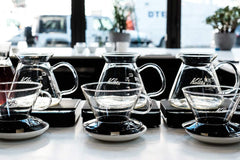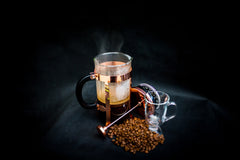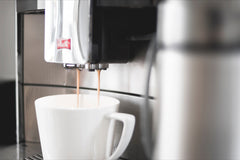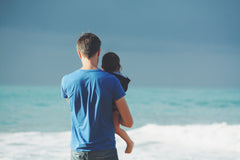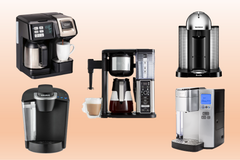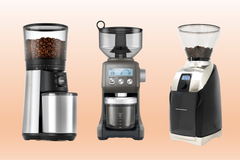We talk quite a bit about the history of coffee, and the culture that surrounds coffee. Still little has been mentioned about coffee and mythology. Kona is one of our favorite coffee origins in the world. However, legend and lore says that without one very special Goddess, we would’ve never experienced the perfection in a cup that is Kona coffee.
Pele is the Hawaiian Goddess of fire and volcanoes. It is her fiery disposition that residents of the islands aim to placate to keep their homes and lives safe from a devastating eruption. While we hope that Pele is happy and content, we can’t help but be a little thankful to her for creating an environment that grows one of the most luscious coffee varieties on earth.

What’s So Special About Kona?
Every origin of coffee has its own characteristics. Kona, grown in the mineral rich, volcanic soil of Hawaii is no exception. One of the things that we think is so unique about Kona coffee beans is how the flavor nuances that come through are reminiscent of the Big Island itself. Kona coffee is known for being well balanced, bright and cheerful with just a touch of acidity. There are undertones that can be detected once you really get to know it, like light floral notes and pinch of spice. Kona is both smooth and complex at the same time.
Kona, being one of the most revered coffees in the world, comes with a price tag to prove it. It isn’t uncommon for people to question the heavier price tag of Kona coffee, especially with so many other great origins in the world. Maybe we can help explain.
For starters, if you have ever been to Hawaii, you know that everything already costs a little more. This is primarily because of the cost of shipping goods to the Islands. Farmers start off playing more for their plants and whatever resources they may require. But, that isn’t the only factor.
Hawaii is committed to treating their farmers fairly. Coffee workers in Hawaii make significantly more than workers in other coffee growing regions of the world. Then there is the fact that coffee growing in Hawaii can be a bit more labor intensive. The terrain of many coffee farms makes it near impossible to use any type of machinery, so the farms are tended to by hardworking and caring hands. These costs are eventually passed on to you, the consumer.
Most people don’t mind though. Kona is just about as perfect as coffee gets and worth every penny.
Oh, The Labels

When you go to purchase Kona coffee, you will come across some labels on the packaging that might be a tad bit confusing to decipher. The first is the grade.
The grade is a label used to describe the overall quality of the coffee bean based on size and appearance. Here is a brief rundown of the grading scale.
- Kona Extra Fancy: This is the premier grade with beans that are clean, with a uniform green color and a minimum screen size of 19. To be awarded an extra fancy grade, there must be no more than 8 imperfect beans per 300g sample.
- Kona Fancy: The next grade down on the scale is used for beans that are clean and uniform in color, but with a minimum screen size of 18, and can have up to 12 imperfections per 300g sample.
- Kona No. 1: This is used to describe beans that are clean and uniform in color, but have a minimum screen size of 16, and can have up to 18 imperfections per sample.
- Kona Select: With this grade, size may vary since there is no minimum size requirement. The beans must be clean and not produce flavors that are sour, medicinal or otherwise undesirable when brewed. Kona select can contain up to 20% defected beans as long as no more than 2% are sour, black or moldy.
- Kona Prime: The same criteria as Kona Select, except that up to 15% of the beans may be defective as long as no more than 5% are sour, black or moldy.
This is good information. But choosing your Kona isn’t as simple as knowing the grades. It is also necessary to read the labels to determine if what you are paying for is pure Kona coffee. If you find a great deal on Kona coffee, it’s probably because it’s a 10% blend rather than the real deal.
The next time you purchase a package of Kona, look for these descriptions:
- 100% Kona Coffee: This is a protected term and can only be used to describe coffee that is 100% real Kona beans.
- Kona Blend: A blend of Kona with other origins. By law this blend must contain at least 10% Kona beans.
- Kona Roast or Kona Style: Neither of these are protected terms and can be used to describe any origin, blend or roast. If you see this labeling on your coffee, chances are it contains no actual Kona beans.
The Search For The Perfect Kona

We can’t think of a better way to search for the perfect Kona than to spend some time touring Kona coffee farms. There’s estimated to be over 650 different coffee farms along the beautiful roads of Hualalai and Mauna Loa. You will find farms of all sizes, from larger production farms to smaller farms that grow only for local clientele.
Most of the Kona coffee farms offer tours. Some will be more elaborate, while others offer a unique opportunity to walk around the small farm and interact one on one with the workers. With so many options, how does one decide where to begin or end their Kona coffee excursion? Here are ten of our choices for the best coffee farms in the region.
- Mountain Thunder Coffee
- Kona Coffee Living History Farm
- Sunshower Coffee Farm
- Holualoa Kona Coffee Company
- Hula Daddy
- Rooster Farms
- Kona Blue Sky Coffee
- Mauka Meadows
- Heavenly Hawaii Coffee Farms
- Greenwell Farms
Lucky for us, there is no bad time to plan a trip to a coffee vacation in Kona. If you want to witness the beauty of blooming coffee plants in all of their white petaled glory, plan a trip earlier in the year. Late January to March is prime blooming season. However, if you are more interested in seeing the ripe berries, and maybe even picking a few yourself, aim for later in the year. The berries start to ripen in April, but hit peak harvest season from August to January.
Where can you find the perfect Kona? Well, the good news is that you don’t need to break the budget on a trip to the Islands. You can experience the perfection of Kona in your own home, along with other wonderful origins and blends from all over the world. Sign up for a Nomad Coffee Subscription today!

